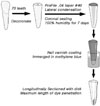Abstract
The purpose of this study was to compare the apical microleakage in root canal filled with Resilon by methacrylate-based root canal sealer or 2 different self-adhesive resin cements. Seventy single-rooted extracted human teeth were sectioned at the CEJ perpendicular to the long axis of the roots with diamond disk. Canal preparation was performed with crown-down technique using Profile NiTi rotary instruments and GG drill. Each canal was prepared to ISO size 40, .04 taper and 1 mm short from the apex. The prepared roots were randomly divided into 4 experimental groups of 15 roots each and 5 roots each for positive and negative control group. The root canals were filled by lateral condensation as follows. Group 1: Guttapercha with AH-26, Group 2: Resilon with RealSeal primer & sealer, Group 3: Resilon with Rely-X Unicem, Group 4: Resilon with BisCem. After stored in 37℃, 100% humidity chamber for 7 days, the roots were coated with 2 layers of nail varnish except apical 3 mm. The roots were then immersed in 1% methylene blue dye for 7 days. Apical microleakage was measured by a maximum length of linear dye penetration after roots were separated longitudinally. One way ANOVA and Scheffe's post-hoc test were performed for statistical analysis. Group 1 showed the least apical leakage and there was no statistical significance between Group 2, 3, 4. According to the results, the self adhesive resin cement is possible to use as sealer instead of primer & sealant when root canal filled by Resilon.
Figures and Tables
References
1. Figdor D. Apical periodontitis: a very prevalent problem. Oral Surg Oral Med Oral Pathol Oral Radiol Endod. 2002. 94:651–652.

2. Hovland EJ, Dumsha YC. Leakage evaluation in vitro of the root canal sealer Sealapex. Int Endod J. 1985. 18:179–182.

3. Teixeira FB, Teixeira EC, Thompson J, Leinfelder KF, Trope M. Dentinal bonding reaches the root canal system. J Esthet Restor Dent. 2004. 16:348–354.

4. Shipper G, Ørstavik D, Teixeira FB, Trope M. An evaluation of microbial leakage in roots filled with a thermoplastic synthetic polymer-based root canal filling material (Resilon). J Endod. 2004. 30:342–347.

5. Tay FR, Pashley DH. Monoblocks in root canals: A Hypothetical or a tangible goal. J Endod. 2007. 33:391–398.

6. Technical data sheet: Rely X Unicem. 2007. St Paul, USA: 3M ESPE.
7. Shin SJ, Lee Y, Park JW. Evaluation of retrievability using a new soft resin based root canal filling material. J Korean Acad Conserv Dent. 2006. 31(4):323–329.

8. De Munck J, Vargas M, Van Landuyt K, Hikita K, Lambrechts P, Van Meerbeek B. Bonding of an auto-adhesive lutimg materials to enamel and dentin. Dent Mater. 2004. 20:963–971.
9. McMichen FR, Pearson G, Rahbaran S, Gulabivala K. A comparative study of selected physical properties of five root canal sealers. Int Endod J. 2003. 36:629–635.

10. Starkey DL, Anderson RW, Pashly DH. An evaluation of the effects of methylene blue dye pH on apical leakage. J Endod. 1993. 19:435–439.
11. Choi JJ, Hong CU. The Effect of Microseal Obturation Technique on the Apical Seal of Root Canals. J Korean Acad Conserv Dent. 1999. 24(2):356–363.
12. Haikel Y, Wittenmeyer W, Bateman G, Bentaleb A, Allemann C. A new method for the quantitative analysis of endodontic microleakage. J Endod. 1999. 25:172–177.

13. Chailertvanitkul P, Saunders WP, Mackenzie D. An assessment of microbial coronal leakage in teeth root filled with gutta percha and three different sealers. Int Endod J. 1996. 29:387–392.

14. Jacquot BM, Panighi MM, Steinmetz P, G'Sell C. Evaluation of temporary restorations by means of electrochemical impedance measurements. J Endod. 1996. 22:586–589.

16. Hwang HK, Park SH, Lee YJ. Comparative study on the apical sealing ability according to the obturation techniques. J Korean Acad Conserv Dent. 2002. 27(3):290–297.

17. Ahlberg KM, Assavanop P, Tay FR. A comparison of the apical dye penetration patterns shown by methylene blue and india ink in root-filled teeth. Int Endod J. 1995. 28:30–34.

18. Tay FR, Loushine RJ, Weller RN, Kimbrough WF, Pashley DH, Mak YF, Lai CNS, Raina R, Williams MC. Ultrastructural evaluation of the apical seal in roots filled with a polycaprolactone-based root canal filling material. J Endod. 2005. 31:514–519.

19. Silveira FF, Soares JA, Nunes E, Mordente VL. Negative influence of continuous wave technique on apical sealing of the root canal system with Resilon. J Oral Sci. 2007. 49:121–128.

20. Sano H, Takatsu T, Ciucchi B, Horner JA, Matthews WG, Pashley DH. Nanoleakage: leakage within the hybrid layer. Oper Dent. 1995. 20:18–25.
21. Tay FR, Pashley DH. Have dentin adhesives become too hydrophilic? J Can Dent Assoc. 2003. 69:726–731.
22. Yiu CK, King NM, Carrilho MR. Effect of resin hydrophilicity and temperature on water sorption of dental adhesive resins. Biomaterials. 2006. 27:1695–1703.

23. Sideridou I, Tserki V, Papanastasiou G. Study of water sorption, solubility and modulus of elasticity of light-cured dimethacrylate-based dental resins. Biomaterials. 2003. 24:655–665.

24. Feilzer AJ, de Gee AJ, Davidson CL. Setting stress in composite resin in relation to configuration of the restoration. J Dent Res. 1987. 66:1636–1639.

25. Bouillaguet S, Troesch S, Wataha JC, Krejci I, Meyer JM, Pashley DH. Microtensile bond strength between adhesive cements and root canal dentin. Dent Mater. 2003. 19:199–205.

26. Tay FR, Loushine RJ, Lambrechts P, Weller RN, Pashley DH. Geometric factors affecting dentin bonding in root canals - a theoretical modeling approach. J Endod. 2005. 31:584–589.

27. Raina R, Loushine RJ, Weller RN, Tay FR, Pashley DH. Evaluation of the quality of the apical seal in Resilon/Epiphany and Gutta-percha/AH Plus-filled root canals by using a fluid filtration approach. J Endod. 2007. 33:944–947.

28. Technical data sheet. Irving Park Rd., USA: BisCem Bisco Inc.




 PDF
PDF ePub
ePub Citation
Citation Print
Print











 XML Download
XML Download